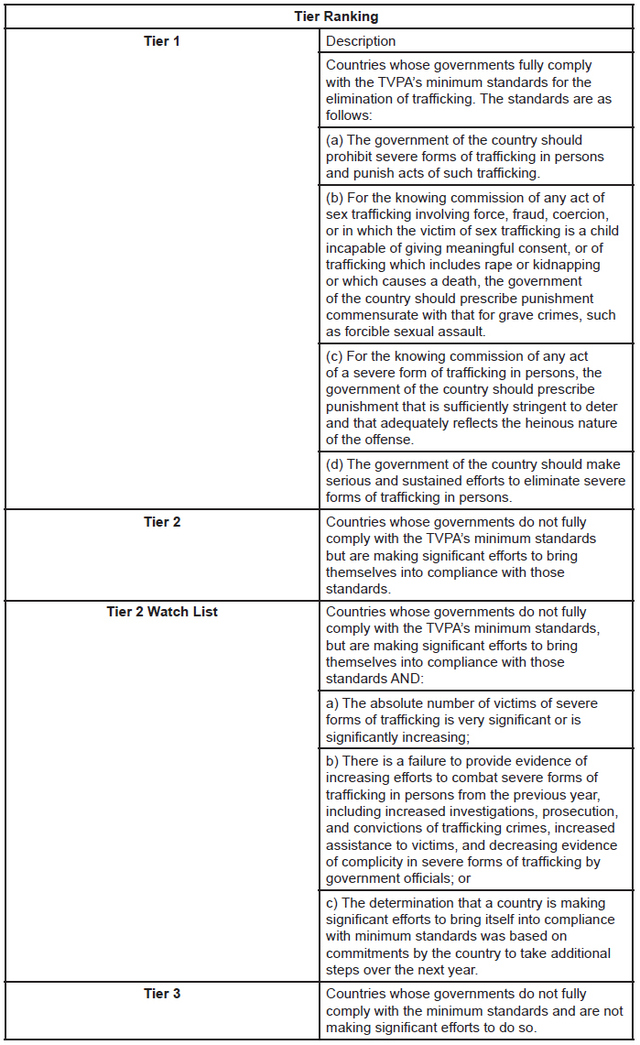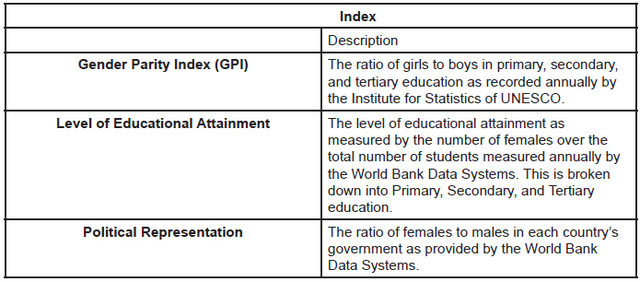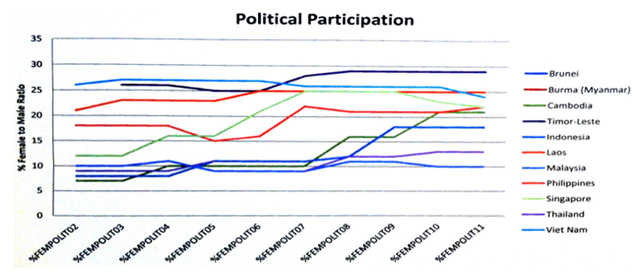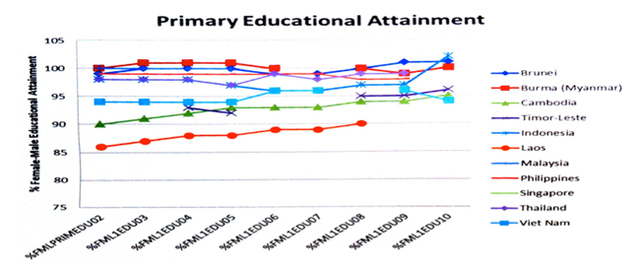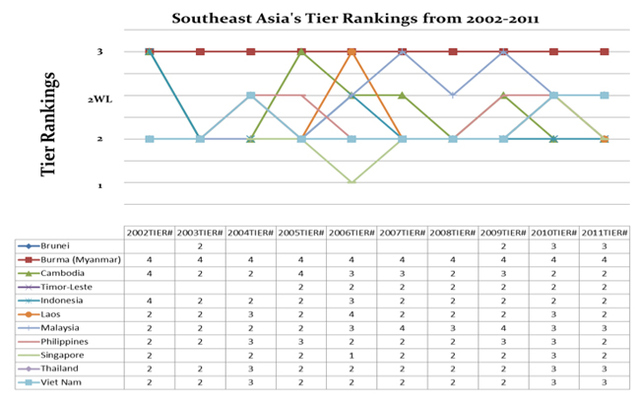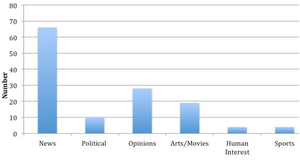From Clocks and Clouds VOL. 3 NO. 1Women in the Schoolhouse, Whitehouse, and Whorehouse: Empowering Sex Trafficked Women in Southeast Asia Through Education and Political Participation
By
Clocks and Clouds 2013, Vol. 3 No. 1 | pg. 1/1
IN THIS ARTICLE
KEYWORDS
AbstractWhile the enslavement of humans has been occurring even before the dawn of written history, today's form of slavery occurs on an unprecedented scale in both scope and reach. This work attempts to understand the most vulnerable sectors of population groups and the strength of the laws in Southeast Asian countries that address the human trafficking epidemic in the region. This endeavor uses quantitative analysis through the linear regression function of the SPSS program to operationalize and see whether the factors of gender parity, educational attainment, or political representation show strong and statistically significant correlations with the strength of anti-trafficking laws. The findings reveal that primary school education has both positive and negative effects on the country's laws depending on the year they were passed. The research is consequential in understanding how policy proposals in each country have varying effects on the susceptibility of certain demographic groups as well as the effectiveness of human trafficking laws in particular contexts. The fundamental question this article seeks to examine is to what extent gender parity, political representation, and education levels for women affect the government action taken against sex trafficking in Southeast Asia. Human trafficking has become a widespread issue that affects 161 countries and over 2.5 million people in the world at any given time (ILO, 2007). With a variety of estimates ranging from 200,000 to 800,000 persons a year, international sexual trafficking has reached worldwide 'epidemic' proportions according to the United Nations Office on Drugs and Crime. Dubbed by a prominent human trafficking scholar Kevin Bales as "modern day slavery," the trafficking of humans takes a wide variety of forms that include forced labor, begging, and sexual exploitation. While the signs and symptoms of trafficked victims vary, one pattern that emerges within the trend is that it yields increasingly high profits at virtually little to no risk. Even the most modest estimations reveal that profits from sex trafficking yield approximately $217.8 billion a year or $23,000 per victim (ILO, 2005). Traffickers have historically faced very little opposition from both their national governments and the international community at large. Only in 2003 with the establishment of the UN protocol on Human Trafficking did countries even begin to have an international standard by which to define the problem. Prior to that, the majority of countries in Southeast Asia used varying definitions of human trafficking that either undermined the gravity of the issue or ignored the problem altogether. Based on the United Nations trafficking protocol, hereby referred to as the Palermo Protocol (Erez, E., Ibarra, P. R., & McDonald, W. F., 2004), human trafficking is defined as, The recruitment, transportation, transfer, harboring or receipt of persons, by means of the threat or use of force or other forms of coercion, of abduction, of fraud, of deception, of the abuse of power or of a position of vulnerability or of the giving or receiving of payments or benefits to achieve the consent of a person having control over another person, for the purpose of exploitation (164). Understanding the breadth and parameters of this definition, sex trafficking is part of a much larger problem that plagues most countries regardless of its political or economic context. While the study of sex trafficking as a global trend is hugely important, a regional focus on Southeast Asia is a more viable and useful area of focus because of the prevalence of sex work throughout the region. Currently the region with the highest number of people involved in sex trafficking, with estimates in the upper 1.4 million, Southeast Asia constitutes 56% of all human trafficking throughout the world (International Labour Organization, 2007). Countries which this paper will analyze in the Southeast Asian region include Thailand, the Philippines, Malaysia, Indonesia, Viet Nam, Singapore, Indonesia, Cambodia, Lao PDR, Burma (Myanmar), and Brunei. In particular, this paper will examine three variables within each country: (1) women's educational attainment, (2) gender parity, and (3) political participation. The task of this analysis is to ask which of these three factors, if any, is a good predictor of the level of government action being taken to regulate sex trafficking in the country. As the results will show, despite the data returning inconclusive, one variable did show strong statistical significance – the level of educational attainment of girls. The findings reveal that primary school education has both positive and negative effects on the country's laws depending on the year they were passed. Interestingly, secondary and tertiary education did not come up as statistically significant. With the disturbing trend of an increased demand for younger girls by an increase of 50% from 1999 to 2006 (Maack, 2008), men seeking to pay girls for sex believe that the younger the girl, the likelier they are to be virgins and free of HIV and other STDs. Rival ViewsModern-day human slavery can be viewed from a variety of angles. In the past it has been analyzed as a legal problem, a gender equality issue, a consequence of systematic poverty and a lack of basic education, a human rights problem, a public health issue, and a multi-national crime problem. While many rival views and explanations exist, this analysis will focus on three main paradigms within each country to explain the strength and efficacy of the laws passed against sex trafficking – the educational attainment level of women, gender parity levels, and the political representation of women within each country's government. These three variables repeatedly come up in the current academic and political debate revolving around the subject and are commonly listed as "push-and-pull factors" in several reports that explain how women are lured into the trap of sex trafficking (Wolfe, 2005; Maack, 2008, UNGIFT 2009; Hodge and Lietz, 2007; et al). It is also important to understand that each of these factors have profound economic effects in terms of market demand and market supply – hence, if any effective anti- trafficking policy is to be crafted and implemented in any country, each of these factors, should be carefully considered. As explained in the table below, the three hypotheses that explain the strength of laws passed against sex trafficking within each country are compartmentalized into three categorical explanations. While all three factors are related to some degree, a distinction must be made in order to understand how each individual factor affects the strength of legislation issued against sex trafficking. Current dialogues between scholars and researchers tend to have a particular focal point when addressing such a complex issue with a wide array of societal consequences. For example, the issue of gender parity is examined closely by Maack and Kuo. Educational attainment, on the other hand, is analyzed by Jan and Mark Rodgers. Lastly, Ekberg and Wolfe expound upon political representation of women in parliament. These viewpoints, while distinct, often times inform and reference each other and acknowledge the importance of the contributions each vantage point brings to the overall analysis. With this considered, the correlation between the three variables may reveal patterns of overlap – a rise in educational attainment may lead to greater levels of gender parity and political representation of women in parliament; or perhaps an increase in women's political representation in parliament may result not only in better legislation for the protection of women and children in the issue of sex trafficking but in the issue of increased educational attainment and gender equality as well. Gender Parity and the Case of Legal ProstitutionAmong the scholars addressing this issue, all seem to agree that the nature of trafficking is highly gendered (Hodge and Lietz, 2007; Emmers, Ralf, Beth, and Thomas, 2006; Kuo, 2000; Leuchtag, 2003; Ekberg, 2004). Among the roughly 800,000 of those trafficked internationally, 70- 80% are women while 50% of them are children. Among them, 70% are trafficked for prostitution and sexual exploitation (U.S. Department of State, 2004). While the working definition provided by the United Nations largely ignores legal forms of sex trafficking and assumes that the state is responsible for all victims of trafficking, others would argue that many voluntary prostitutes see themselves as workers seeking to improve their economic conditions and not as victims (Kuo, 2000). In her article, "Asia's Dirty Secret," Kuo argues that policy should be clear to distinguish between voluntary sex work and those who are coerced or deceived into working. While many of its proponents see that a clear line between volunteerism and coercion is difficult to draw, they do see the need to expand economic opportunities for women who have limited options for work. In focusing on the political factors that shape and inform a woman's choice to be involved in the sex trade, Kuo focuses in on the issue of gender parity and the prevalence of patriarchal and misogynist cultures in Southeast Asia. In the study, Kuo reveals how female prostitutes are often times abused and exploited by their pimp or partner, “Studies have found a direct correlation between the extent of violence against the prostitutes and the level of illegality of the work" (Kuo, 45 2000). While Kuo sees prostitution and legal sex work as an integral part of the Southeast Asian economy, Maack argues for better distinctions in the law between sex slaves and professional prostitutes. While human trafficking is illegal in all Southeast Asian countries, prohibition is rarely enforced because of culturally ingrained attitudes about women and the fact that sex is a highly lucrative enterprise (Maack, 2008). The overt commercialization of women in many Southeast Asian societies from Brunei to Vietnam leads to a reinforced normative reality that women's sexuality can be bought with a price. Because women are treated as second-class citizens in these cultures, schooling and job opportunities in the region are limited. Most legal and well paying jobs are given to men because most girls do not get the kind of educational training their male counterparts receive. Hence, women are left with very few options for licit and gainful employment – and with sex work being one of the more lucrative options for women to engage in, many end up entangled in a web of abuse and exploitation in the sex-trade industry. With Maack's call to a victim-centered perspective of sex trafficking, more adequate responses and policies can be instituted to help rather than hurt the 70-80% of trafficked women through empowerment. Using both expansive economic and educational opportunities, women go from being potential targets of traffickers to proponents of change and political advocates for the thousands of other women trapped beneath the glass ceilings of brothels and misogynistic cultures. According to Maack, Women and children are not viewed on an equal platform with men, their human rights are not fully recognized within their own societies and cultures. Prostitution is often viewed as completely acceptable or normative as a pervasive social phenomenon, and not as a violation of human rights […] When women and children are forced into sexual slavery they fall under the same laws regarding professional prostitution, rather than recognizing that involuntary sexual-slavery is a violation of their innate human rights (6). While there are many ways to address how women and children are lured into the sex trade that include disbanding legitimate organizations that traffic children to increasing attempts at stopping and apprehending large crime syndicates and transnational organizations that kidnap children (Hodge & Lietz, 2007), this viewpoint sees that the end of the sexual slavery begins by empowering women to recognize their inherent equality as persons rather than as mere objects of sexual gratification. Increasing Education Levels for WomenGeneral consensus shows an upward trend in the quantity of children being educated as well as a general increase in higher levels of education. Scholars such as Jan and Mark Rodgers have seen how general education can be a good preventative measure that equips women and children against potential threats from sex traffickers and other sexual predators. According to the Rodgers' report, “the lack of public education about sexual abuse and domestic violence, coupled with poverty, low economic resources and lack of job opportunities contributes to the sexual exploitation of women and girls" (Rodgers, 2005). In order to better understand the relationship between education levels and the gravity of and response to sex trafficking, they utilized the Prevention, Education, Assessment Coalition Model (ABA/LALIC) in Ecuador – a measure of a number of factors such as, "(1) organizations around the country working on trafficking and trafficking-related issues; (2) major trends/themes in the trafficking and anti-trafficking activities; (3) gaps in service and public policy as well as the existing legislative framework for prosecution; and (4) recommendations for the ABA/LALIC project" (Rodgers, 2005). In crafting the study, the ABA/LALIC focused on public awareness and education. Targeting local communities, parents, schools, libraries, victims/survivors, and service providers, the ABA/LALIC proposed things such as a "stay in school program" which includes qualified teachers to keep children off the streets and less vulnerable to traffickers. This framework of measuring prevention of sex trafficking recruitment through education and community-based initiatives is adopted to suit the question of whether greater levels of educational attainment will improve the kind of legislation present in a country. What the ABA/LALIC noted in the study was the willingness of students to organize and start movements about the issue. Yet, while the good intentions exist to battle sex trafficking in many countries, there seems to be a lack of young children who say that they know where they can find help. With this in mind, the ABA/LALIC surveyed women who claim to have been victims of sex trafficking to see what levels of education they had attained. What they found was a various spread with 15% having post graduate degrees, 46% having college level education and 33% with high school education. They followed this up with a post training evaluation survey that had questions clearly about the sex trafficking industry. Their conclusion states, Significant findings suggest that there was knowledge gained by the students about human trafficking. It also indicated that training increased their motivation to start a student organization. Knowledge is important to help children and students to protect themselves which is crucial in the safety of children. Results indicate that training is an effective method in having children gain knowledge on the subject of human trafficking and have the tools necessary to protect themselves and to organize student organization to support and help others (11). The data gathered indicated that the level of skills in assessing victims of human trafficking by professionals increased and also suggested that education is a powerful and effective model in working to empower women to fight against sex trafficking. Empowering Women through Political ParticipationWhile gender parity and educational attainment levels are good suspects for what kind of laws are created to prohibit sex trafficking within a country – Leslie Wolfe and Gunilla Ekberg would argue that the leading suspect is, in fact, the need for women's issues to be better represented and championed by greater numbers of women in parliament. Shirley Chisholm who served in Congress in the 1970s stated, "The law cannot do the major part of the job of winning equality for women. Women must do it for themselves. They must become revolutionaries" (Ekberg, 2004). The fact that laws are in place to prohibit human trafficking in all countries yet are usually treated with impunity and often times persecute the victim as well as the trafficker goes to show the lack of intentional purpose, reach, and scope that is necessary for such laws to protect the rights of women who are victims of sex trafficking. Wolfe argues the need for more women and feminist representatives in the government in her treatise, "Fighting the War on Trafficking of Women and Girls: The Role of State Legislatures." In it, Wolfe argues that, "task force members must include top level state officials – attorneys general and secretaries of health, human services, and social services – as well as state and local law enforcement and key members of the state legislature [.] Of utmost importance, experts on women's human rights must be leading members of these task forces" (Wolfe, 2005). Organizations such as the Center for Women Policy Studies is currently paving the way to craft the proper legal and policy framework that enables local and national governments to prosecute and punish traffickers while protecting the women and girls who are victims of sex and labor trafficking. According to Wolfe, trafficking of women and girls is a, "disease of patriarchal society, the quintessential violation of women's autonomy and human rights and the ultimate reflection of women's status as the property of men, as commodities and as creatures who exist primarily to service men's sexual desire" (Wolfe, 2005). Because all governments and societies within Southeast Asia tend to be male-dominated – women's issues are often times pigeon holed as women's rights rather than human rights. Wolfe and Ekberg attempt to remedy this by increasing the number of women's rights representatives in both government and politics. According to Wolfe, [Governments] must include advocates for refugee and immigrant women, providers of services and support for survivors of domestic violence and sexual assault, advocates for women's human rights in multiple arenas, community based organizations that serve women and girls and the feminist scholar activist whose research is essential to our understanding of these issues (Wolfe, 188- 189 2005). In places such as Sweden where fighting sex trafficking is a priority of the country's government, these efforts are seen as crucial to creating a democratic society where “full gender equality is the norm” and recognizes the right for men and women equal participation in all areas of society. While Wolfe and Ekberg only provide a single case study in understanding the role of increased female representation in government in fighting sex trafficking, Sweden is seen as a pioneer in championing women's rights and equal representation for highly gendered issues such as sex trafficking. RelevanceThis study is important for several reasons. First, sexual exploitation and trafficking are on the rise and increasingly more globalized than ever. While sex workers from Asia are trafficked to the most numerous regions, Europe remains to be the largest recipient of sex workers from the widest range of destinations. The Americas also make up the second largest demographic of sex tourists in Southeast Asia. Even Japan has an entire underground economy created with the sole purpose of importing sex workers from Thailand and the Philippines. In 1996, these three economies and Australia contributed nearly five million sex tourists in Thailand alone, bringing in $26.2 billion – thirteen times more lucrative than the exporting of computers in Thailand. Some 50,000 women and children are trafficked into the United States each year, mainly from Asia and Latin America (UN GIFT). Second, the rise of sex trafficking is inextricably tied to the rise of HIV/AIDS in the region. According to a recent quantitative study done by the UNDP entitled "Sex Trafficking and STI/HIV in Southeast Asia," "findings revealed a consistent pattern that women who were victims of sex trafficking, appear to suffer qualitatively and quantitatively different and greater levels of sexual risk [and…] provide consistent evidence that trafficking of women and girls for sexual exploitation places such individuals at high risk for HIV/ STI infection" (UNDP, 4 2009). What was seen as an epidemic in the African continent in the 1980s has increasingly become a health catastrophe in the Southeast Asian region as well. In a span of just 20 years, Southeast Asian countries that have relatively high rates of sex trafficked women also experience increasingly high rates of their population living with HIV. According to the most recent statistics, Thailand's sex trafficking problem is only slightly below that of Ghana. Minding the Gaps in DataIn the course of research and data collection, it has become evident that there is a huge gap of knowledge due to the lack of reliable and useful statistical data regarding the subject. There is considerable variety and inconsistency in the quantitative data available. Most of the studies pertaining to sex trafficking in Southeast Asia tend towards case studies rather than statistical analysis. Because of that, studying both legal and illegal forms of sex trafficking often yields questionable and inconclusive results because the numbers most social workers use are rough estimates. Each organization collects its own data and operates with the assumption that their data is the most accurate. Unfortunately, the gap between estimates is often so large that institutions and governments craft policy that either overemphasizes sex trafficked victims or under represents them (see Data Comparison Sheet #1 below). Despite these setbacks, what can be better understood is whether gender parity, educational attainment, or female political participation is a better predictor of sex trade supply in Southeast Asia. In order to do so, this review examines the data readily available from reliable data sets from the UN Global Initiative to Fight Trafficking (UN GIFT), United Nations Educational, Scientific and Cultural Organization (UNESCO,) the World Bank, and UNICEF in order to understand the general consensus in each country's attitudes towards sex trafficking as well as the debate over what is the best predictor of what will produce better laws against human trafficking. Research DesignIn order to operationalize how gender parity, educational attainment, and female representatives in parliament affect the laws being passed in each country, we begin by establishing both dependent and independent variables. While other factors such as the size of the economy, poverty rates, drug use, and prevalence of birth control could have been used as independent variables to measure the strength of anti-trafficking laws in each country, many of the existing field research (Maack, 2008; Rodgers, 2005; Wolfe et. al, 2005) refer to gender parity, educational attainment, and female political representation to understand the symptoms of sex trafficking which include high levels of violence against women, a low availability of licit and gainful employment for women, and limited or failed cases of prosecution of traffickers. Individually considered, gender parity is used as an independent variable because we expect to see weaker laws against trafficking in countries where a low level of gender parity exists. A level of educational attainment is also considered because we expect to see stronger laws against trafficking in countries that place a high premium on women's education. Furthermore, educational attainment is a key factor in social, political, and economic development. Lastly, we consider female political representation as an independent variable because of the role female political figures play in ensuring strong laws are passed to prosecute traffickers as well as to protect the victims of trafficking. Ideally, a perfect dependent variable would be to measure the real numbers of enslaved sex trafficked women in Southeast Asia. Unfortunately, no official numbers of sex workers exist because prostitution is technically illegal in all Southeast Asian countries. While the best estimates are provided by Coalition Against Trafficking in Women (CATW) that rank Thailand as the country with the highest number of prostitutes ranging from estimates between 300,000 to 2.8 million women – a third of whom are minors, the data estimates provided are extremely unpredictable and leave a huge margin of error when analyzed. Hence, an alternative way of measuring sex trafficked women is through the proxy variable of the Trafficking in Persons Report (TiP report) done annually by the U.S. State Department. The tier systems, while an imperfect measurement of the effectiveness of the laws, at least follow the trend of numbers involved in sex trafficking – with Thailand having 52.6% of its population involved in the informal economy followed by 43.4% in the Philippines. Dependent VariableIn order to best understand the relationships between the independent variable of each country's tier ranking and the dependent variables of gender parity, educational attainment levels, and political representation, each variable in the compiled data set was run through a linear regression for each year beginning in 2001 when the country tiers were established up until the present day. This endeavor primarily entailed quantitative analysis operationalized using the linear regression function of the SPSS program. This process attempts to find strong significant relationships and positive or negative correlations as well as counter-intuitive patterns that may be revealed after the data has been processed. The significance level cut-off in order for a variable to be deemed as statistically significant is for the P-value to be less than 0.1. The effects are significant at the 90% level. In order to better understand the basic general trends and movements of each variable, graphs are also included to measure each variable over time. DataAnalysisAfter running linear regressions on each of the dependent variables over the independent variables, results returned inconclusive. Although it is important to note that two variables were deemed highly statistically significant. The first significant factor is a measure of significance of educational attainment levels and how they relate to country tiers in 2002. What the data revealed is a .087 significance that passed the test for needed value in order for it to be deemed statistically significant at the 90% level. As there is a .3 increase in Tier ranking, meaning the laws got weaker, as there was an increase in numbers of primary education attainment for girls in 2002. Interestingly, the data revealed opposite results for the same variable in 2004. As the percentage of female-male primary education attainment rose, a .237 decrease in Tier ranking occurred, meaning the laws become stronger. Based on the data, no firm prediction can be made conclusively. Because the same variable of primary education both confirms and rejects H2 for different years – 2002 rejects the hypothesis while 2004 confirms it, the results are said to be inconclusive. But this is not to say that general inferences cannot be made. Based on general trends of the graphs that account for the primary levels of education for women and the graph that accounts for the each country's tier ranking, we can infer a correlation between the increase in primary educational attainment and Tier Ranking. Policy ImplicationsThe data makes sense in terms of Hodge and Lietz's "push-and-pull factors" – variables that argue that while some variables push individuals away from their originating country, others pull them towards countries that have glamorous industrialized nations. Although they cite most of the push- factors to be economic such as poverty, war, and the lack of a promising future to foster discontent, the pull-factors they mention are sociological such as media-constructed images that offered a chance at a better life. Children in primary school are particularly vulnerable to sex traffickers. Because the years spent primary school is an age where young boys and girls are most impressionable, this leads them to believe that a family friend or even an acquaintance that offers them a better life will deliver on such promises. Instead, the situation that many young girls find themselves in is no paradise but a reality of hellish sexual and psychological abuse that lasts for years. When it comes to regulating the world's oldest profession, scholars and policy makers are divided as to what, if anything should be done with the issue of sex trafficking in Southeast Asia. Although the trafficking of women and children across domestic and international borders is an ancient phenomenon, it poses serious contemporary social, political, and economic complications in an increasingly globalized world. Because of its lucrative nature, positive influence in employment rates, national income, and the region's economic growth, scholars and policy makers often rationalize sex trafficking as a profitable industry in the rising Southeast Asian economy. But in spite of the economic benefits of sex trafficking, it comes at a high cost to the region's social and political development. The prominence of both legal and illegal sex trafficking industry in the ASEAN countries makes their economies dependent upon the presence of this industry. Scholars and policy makers alike also share a common understanding of the lucrative nature of the sex trade industry with modest numbers in the estimation of about 200,000 sex slaves generating an annual profit of around $10.5 billion for their slaveholders (Leuchtag, 2003), sex trafficking is the second most lucrative form of organized crime next to narcotics and arms sales (U.S. Department of State, 2004). Because there exists an understood assumption that sexual exploitation almost always involves fraud and deception, the issue of consent is deemed irrelevant by the United Nations. Because of the fraudulent and deceptive nature of sex traffickers, as the data has revealed the primary years of a child's education is crucial in being able to protect them against being caught in the snare of sex trafficking rings. The most important policy implementation that can be made are Southeast Asian governments commitment to protect and inform both the children and their parents of the threat of sex trafficking from the early years. This can be done through increased investment in educational infrastructure and the creation of a division in the Department of Education in each country that deals solely with raising awareness of the issue and where children and parents can run if they find themselves being solicited by a trafficker. Question of Legalizing ProstitutionWhile the issue of prevention through childhood education is crucial in combating against sex traffickers, the question remains whether or not the legalization of prostitution will help distinguish between sex slaves and professional sex workers. No research exists that conclusively proves that legal prostitution decreases illegal prostitution. Trends reveal, however, that legalization only seems to increase both legal and illegal prostitution while nations that already have legalized prostitution such as the Netherlands and Germany, have become magnets for traffickers (Erez, E., Ibarra, P. R., & McDonald, W. F., 2004). While liberal Feminists like Kuo tend to argue for the temporary necessity of prostitution as a legitimized market within the Southeast Asian economy, Leuchtag makes a stronger case against Kuo by arguing using the case study of the legalization of prostitution in Victoria, Australia. In her argument, she warns policy makers against the pervasive assumption that legalizing prostitution will diminish the negative effects suffered by women in the sex industry such as violence, exploitation, and health effects. What the case study reveals in Victoria, Australia is that legalization led to the strengthening and perpetuating of the culture of violence and exploitation inherent in prostitution. Under the auspices of protecting voluntary prostitutes, the legalization of the industry only led to the proliferation of both legal and illegal brothels all the while increasing the trafficking of women in order to meet the new demand (Leuchtag, 2003). She continues to warn against the assumption that the "Amsterdam model" works to protect prostitutes within the country. In reality, this model that legalized prostitution in the name of “self-determination and empowerment for women,” failed on multiple levels to protect the health, safety, and welfare of the women in the country. In Amsterdam's 250 officially listed brothels, 80% of the prostitutes were trafficked from other countries – of which 70% possess no legal papers. Leuchtag argues that legitimizing prostitution merely allows the government to wash its hands clean in giving men the "right" to buy, sexually use, and profit from the sexual exploitation of someone else's body. In arguing so, she cites economic desperation as a driving factor, failed policy initiatives as an open invitation for recruiters of the sex industry, while the patriarchal culture often acts as a conduit to sex work in seeing women as a “cash crop” to be exploited by both men and the state. While men use women as an object for their sexual pleasure, the state has often used them as a means to pay off interest on the foreign debt. Leuchtag discusses the dangerous policy implications of viewing prostitution from the human-rights approach and that, historically speaking, governments with the higher demands for sex trafficking are also the same ones to want to separate issues of trafficking from that of prostitution. The most recent and noticeably effective political measure taken to combat sex trafficking was instituted in Sweden. Since its adaptation of the Law That Prohibits the Purchase of Sexual Services in 1999, the country has seen a mixture of a stagnant and often steady decline of men procuring sex and has been touted as a model for crafting policy against prostitution. According to Swedish law, prostitution is viewed as a form of male sexual violence against women and children. By implication, men who purchase sexual services from women are criminalized rather than the women who are provided with services to assist them in leaving the prostitution industry. Further sanctions are placed against Swedish citizens by subjecting them to prosecution if they are caught attempting to procure sexual services anywhere in the world (Ekberg, 2004). Although no other country has followed Sweden's lead, data reveals promising results in diminishing the demand for sex workers from Southeast Asia. If this is the case, then the laws of basic macroeconomics are in our favor and we may, perhaps, see the supply follow the downward trend of demand. ConclusionsWhile the data from this research reveals no definite conclusions in which factors are the best at predicting the efficacy of laws, there appears to be a correlation in the data of primary level of education and the extent to which laws are passed to protect women and children against sex trafficking. However, because of the small sample size, gaps in the available data, and a lack of information regarding the quality of primary education in each specific context, no firm conclusions can be made and the results should be taken loosely. Further research should focus on the relationship between primary education and the strength of anti-trafficking laws in each individual context. But if the findings reflected the reality of sex trafficking in the Southeast Asian region, with better preventative measures installed in primary schoolhouses, we should hope to see an overall decrease in sex trafficked girls in the future. While other variables will shape and affect how the sex trade will look in any particular context, there are still clear political sanctions that can be enforced in order to protect and educate the victims and punish the sex trafficker. As this inquiry has determined, governments must integrate better preventative measures in the primary schools to protect children where they are most vulnerable. As we see schoolhouses become more and more equipped to protect and inform their students, we hope to see more efficient laws and less girls recruited for brothels. ReferencesLeuchtag, Alice. "Human Rights Sex Trafficking and Prostitution." Humanist. 63. no. 1 (2003): 10-16. Kuo, Michelle. "Asia's Dirty Secret: Prostitution and Sex Trafficking in Southeast Asia." Harvard International Review. 22. no. 2 (2000): 42-46. Hodge, David R., and Cynthia A. Lietz. "The International Sexual Trafficking of Women and Children."Journal of Women and Social Work. 22. no. 2 (2007): 163-174. Ekberg, Gunilla. “The Swedish Law That Prohibits the Purchase of Sexual Services.” Violence Against Women. 10. no. 10 (2004): 1187-1218. U.S. Department of State, "Trafficking in persons report." (2004) Accessed March 19, 2012. http://www.state.gov/g/tip/rls/tiprpt/2004/34021.htm. Erez, E., Ibarra, P. R., & McDonald, W. F. "Transnational sexual trafficking: Issues and prospects." International Review of Victimology. 11. (2004): 1-9. Yea, Sallie. "When Push Comes to Shove: Sites of Vulnerability, Personal Transformation, and Trafficked Women's Migration Decisions." SOJOURN. 20. No. 1 (2005): 67-95. Maack, Jenna. "Sex Trafficking in Southeast Asia: the need for a Victim-Centered Perspective." Last modified Spring 2008. Accessed May 9, 2012. Leslie, Wolfe. "Fighting the War on Trafficking of Women and Girls: The Role of State Legislatures." The Georgetown Journal of Gender and the Law. 6. no. 2 (2005): 179-192. Jan, Rodgers, and Rodgers, Mark. North American Association of Christians in Social Work, “Prevention, Education, and Intervention Strategies in Combating Human Trafficking: Collaborative Efforts Producing Sustainable Action." Last modified February 28. Accessed May 9, 2012. http://www.nacsw.org/Publications/Proceedings2008/RodgersJPrevention.pdf. Suggested Reading from Inquiries Journal
Inquiries Journal provides undergraduate and graduate students around the world a platform for the wide dissemination of academic work over a range of core disciplines. Representing the work of students from hundreds of institutions around the globe, Inquiries Journal's large database of academic articles is completely free. Learn more | Blog | Submit Latest in Political Science |





